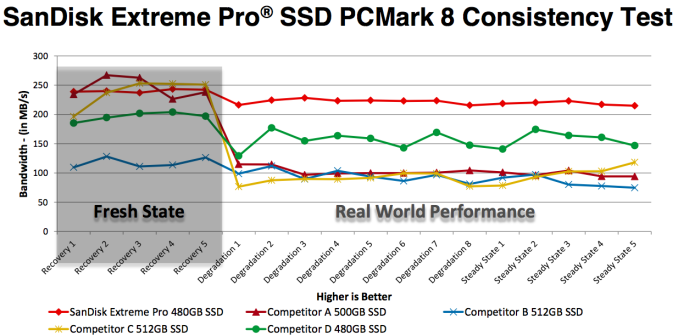Computex 2014: SanDisk Announces Extreme Pro SSD
by Kristian Vättö on June 3, 2014 11:40 AM EST- Posted in
- Storage
- SSDs
- SanDisk
- Extreme Pro

Continuing our Computex coverage, SanDisk is launching their new flagship Extreme Pro SSD today here in Taipei. SanDisk is targeting the enthusiast and professional crowd with the drive by promising the most consistent performance in a consumer-class SSD along with an industry-leading warranty of 10 years (!).
The Extreme Pro supports SanDisk's nCache Pro technology, which should be similar to SanDisk's regular nCache technology found in other drives but with more focus on consistency rather than peak performance.
SanDisk isn't disclosing the controller under the hood but given SanDisk's history with Marvell, I'm pretty confident that the controller is either Marvell 88SS9187 or 88SS9189. The NAND is SanDisk's 1Ynm, which in layman terms means SanDisk's/Toshiba's second generation 19nm node also known as A19nm.
The Extreme Pro will be available later this month through SanDisk's retail partners and the MSRPs are $189 for 240GB, $369 for 480GB and $599 for 960GB. We will be meeting with SanDisk here at Computex and are hoping to get more details, so stay tuned for updates!












6 Comments
View All Comments
MrCommunistGen - Tuesday, June 3, 2014 - link
If it is Marvell 88SS9187 or 88SS9189 I'd really like to know what the secret sauce is that SanDisk found to extract all that raw (peak?) performance that's in the table AND the consistency that's in the graph. Of course there's a reason they call it "secret" sauce.On the flip side, could the primary performance difference between the Extreme Pro and other Marvell SSDs like the M550 be something as simple as Toggle NAND vs ONFI based NAND?
LtGoonRush - Tuesday, June 3, 2014 - link
Remember that Marvell doesn't provide their own firmware, so each drive based on a Marvell controller is using in-house firmware, that's primarily where the differences come from. Additionally SanDisk's nCache technology (similar to TurboWrite on the Samsung 840 Evo) allows a portion of the MLC die to be used as SLC, improving performance. This drive looks like a worthy successor to the SanDisk Extreme II, but I'm not sure if even most enthusiasts can justify the premium over the Samsung 840 Evo. I guess if you have write-heavy workloads that will burn through the cache it makes sense.athlonotaku - Saturday, June 7, 2014 - link
The premium is worth it if the drive comes with a 10 year warranty... "SanDisk is targeting the enthusiast and professional crowd with the drive by promising the most consistent performance in a consumer-class SSD along with an industry-leading warranty of 10 years "Sabresiberian - Sunday, June 15, 2014 - link
I paid the premium for a 240GB version of the Extreme II because performance consistent was at the top of the charts when I bought - and 5-yr warranty instead of 3.But then the Extreme IIs went on sale, and having quickly found out that the 240GB wasn't enough for my purposes I bought more. I paid $300 each for 2 480GB Extreme IIs (I would have purchased more 240GB units but the discounted ones were sold out at the time), which meant the cost/GB was close enough to the cheaper SSDs that price wasn't an issue.
Moral of that story - look at the prices of what interests you at the time you are buying, because suggested retail is only a rough guide. :)
hojnikb - Tuesday, June 3, 2014 - link
Yeah, firmware has probobly a lot to do with the performance consistency and IO performance aswell. Flash is also a big factor here, since Crucial is using 128Gbit die flash, while sandisk is most probobly using 64Gbit. Some differences could also come down to different DDR memory configuration and controller clock speed.JlHADJOE - Saturday, June 7, 2014 - link
Extreme and Pro. Because one superlative is not enough!